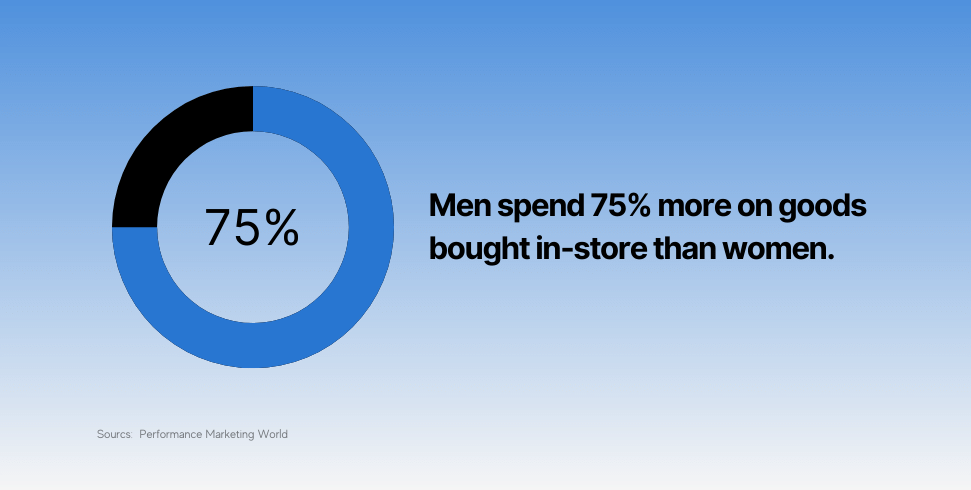How much do men and women spend differently when it comes to shopping?
According to a study by Forbes, on average women spend almost twice as much as men each month on apparel, accessories and cosmetics. However, there are also some categories where men tend to outspend women.
Let’s take a look at some of the most interesting male vs female spending statistics in general, as well as in specific areas such as clothing, food, healthcare, and travel.
Editor Choice: Male vs Female Spending Statistics
- Men spend 47% more on purchases than women, and 75% more in-store.
- Men shop online more frequently than women. 24% of men shop online at least daily, compared to 17% of women.
- 70% of men shop online weekly, compared to 57% of women.
- 60% of respondents who identified themselves as primary shoppers in their household were women, while 50% were men.
- Men spend 75% more on goods bought in-store than women.
- 61.3% of shoppers are women, and 38.7% are men.
- Women account for 85 percent of all consumer-buying decisions contributing an astounding $15 trillion to the economy, hold more than 60 percent of all personal wealth. (Forbes, Federal Reserve, Gallup, BusinessWeek, MassMutual Financial Group)
- Single men outspent single women, but only by a slight margin. Men spent an average of $35,018 a year while women spent $33,786.
- Women Controls over $31.8 trillion dollars in worldwide spending. (Catalyst)
- 38% of men and 36% of women are likely to spend more on goods from online marketplaces
- Women on average spend out $323 per month for groceries, whereas men averaged $290.
- Men spend on average $21 for lunch while women hover around $14.
- An average person spends $161 per month on clothes with women spending 76% more than men per year.
- Men spend almost twice as much as women on vehicle purchases ($1,670 per year compared to $2,900 per year, on average).
- Men spent an average of $835 on “audio and visual equipment and services” but only $206 caring for pets. Women, by contrast, spent $725 on their home theatres and $488 on their pets.
- During the time period of age 18 to 44, health spending for females is 84% higher than for men for years.
- They discovered that 68 percent of ladies have spent money on these items online, while men have spent 52 percent of their money.
Sources: (Charged Retail, Sage Seller, Forbes, Jungle Scout, Performance Marketing World, Zippa)
Men Outspend Women by 47%, Display 75% Higher In-store Purchases
Important takeaway:
| Men have higher expenditure | Men, on average, spend 47% more on purchases, indicating they may prioritize bigger-ticket items. |
| In-store shopping is preferred by men | The data shows men spend 75% more in-store, suggesting a preference for physical shopping experiences. |
These statistics infer that while women might be more engaged in shopping activities, men tend to spend more on their purchases. Additionally, men appear to favor in-store shopping experiences over other channels.
Source: Charged Retail
24% of Men Shop Online Daily, Outdoing Women by 7%
Important takeaway:
| Prioritize men in eCommerce strategies | Men shop online more frequently, indicating higher potential for consumer engagement |
| Offer daily deals or promotions | Frequent online shopping suggests daily incentives may increase purchases |
| Increase targeted marketing for women | Lower percentage of women shopping daily indicates untapped market potential |
This data suggests that businesses should prioritize men in their e-commerce strategies due to their more frequent online shopping. However, the lower frequency of women shopping daily shows an untapped potential for targeted marketing initiatives.
Source: Sage Seller
Weekly Online Shopping: Men Lead at 70%, Women Trail at 57%
Important takeaway:
| Men shop online more regularly on a weekly basis. | Weekly promotions or deals could be tailored to cater to male shoppers. |
| Women shop online less frequently each week. | Efforts to engage women in weekly shopping should be intensified. |
| There is a gender disparity in weekly online shopping habits. | Understanding the preferences of both genders can help in creating a balanced strategy. |
| Men have a high level of online shopping engagement. | Regular updates and new product releases may attract this active customer base. |
Source: Forbes
60% of Primary Household Shoppers are Women, 50% Men
Important takeaway:
| Women are the primary shoppers | A majority, 60%, self-identify as the primary shoppers, implying greater involvement in household shopping decisions. |
| There is near parity among genders | Despite women leading, a significant 50% of men are also primary shoppers, pointing to evolving gender dynamics in household tasks. |
This data indicates a shift in traditional gender roles within households, where both men and women actively participate in shopping tasks, promoting more balanced domestic responsibilities.
Source: Jungle Scout
In-store Shopping: Men Outshine Women, Spending 75% More

Important takeaway:
| Men are significant spenders in in-store purchases. | Retail strategies should prioritize men for maximizing sales. |
| Women spend considerably less in-store. | Marketing strategies may need to be adjusted to attract female in-store shoppers. |
| Men’s in-store spending dominance is evident. | Store layout and promotions should cater more towards men’s preferences. |
| Significant gender-based spending differences exist. | In-depth understanding of gender shopping habits can drive profit growth. |
Source: Performance Marketing World
Women Dominate Shopping Demographics, Representing 61.3% of Shoppers
Important takeaway:
| Women dominate shopping activities | With 61.3% involvement, women are significantly more engaged in shopping than men. |
| Men’s shopping engagement is noteworthy | Although lesser, the 38.7% indicates a substantial involvement of men in shopping activities. |
These statistics highlight a notable, yet not absolute, gender divide in shopping activities. While women are the dominant participants, a considerable proportion of men also partake, reflecting changing societal norms.
Source: Zippa
Source
Louisiana